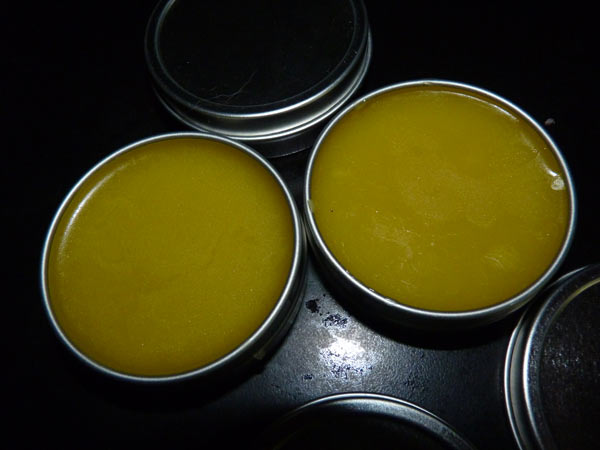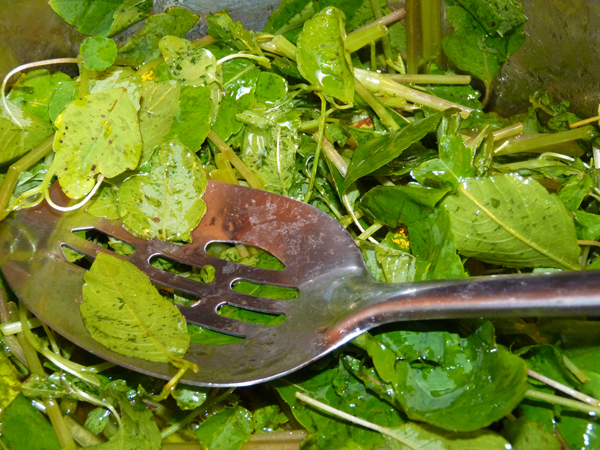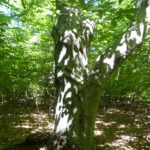I think sometimes that we forget about the bounty that nature provides us.
Jewelweed is a common plant found in most of the USA. It grows about 3′ high and has little spotted touch me not flowers and little pods that explode when touched. For more information and photos on identifying Jewelweed, follow this link. It is found in forests, along swampy edges, and in shady areas. While most people think this is a pretty weed, it actually has wonderful healing and restorative properties. Here are a few:
- Walking in the forest and get bit by a mosquito? Use some fresh jewelweed.
- Picking berries and get scratched by brambles? Use some fresh jewelweed.
- How about that pesky stinging nettle? You guessed it, jewelweed.
I sought to create a salve that could be used year-round that contained jewelweed’s restorative properties. Here’s what I came up with–it works wonderfully on burns, cuts and bug bites!
Jewelweed Salve
You’ll need the following ingredients:
- 6 cups fresh jewelweed, coarsely chopped
- 2 cups good quality olive oil
- 1 1/2 cups loosely packed grated beeswax (you can use more or less, depending on how thick you want your salve. If you add more, it will become the consistency of lip balm; less, the consistency of a jelly. This amount is somewhere in between).
- Essential oils: Tea Tree, Lavender, and Sweet Orange (or others of your choice, just make sure they are skin safe; the ones listed have healing/antiseptic properties).
And the following equipment:
- Small pot
- Strainer
- Small containers to put in your finished salve. I like using these from Mountain Rose Herbs.
Directions
- Go out and pick your fresh jewelweed. I picked mine just as they were done flowering.
- Once you have picked it, rinse it off, removing any dirt or roots that you pulled out.
- Coarsely chop up the jewelweed and add it to the pot. Add the 2 cups good quality olive oil.
- Bring the oil to a simmer, and simmer the Jewelweed for 1 hour until it is cooked down.
- At this stage, I will cover the pot and let it cool down, then let it sit overnight before finishing the recipe. This allows the jewelweed to be infused with the olive oil.
- Strain the jewelweed from the olive oil. If you have a cheesecloth, this works best. I didn’t have one last time I made it, so I used a metal strainer and a metal spoon. Rinse out and dry your pot so no jewelweed particles are left in the pot.
- Grate your beeswax and measure it out. I suggest adding less beeswax at first so that you can get the consistency of the salve you want.
- While you are grating, heat your jewelweed-infused olive oil back up. Add your beeswax. Stir until the beeswax is melted.
- To check the consistency of your salve, you can put a spoon in the freezer and then drop a little bit of the mixture onto the spoon. It should solidify and then you can see how thick it is, and if you want it thicker, add more grated beeswax.

Make sure the beeswax is fully melted. This image shows the mixture after essential oils are also added. - Once you are happy with your consistency, add about 20-30 drops of essential oil to make it smell nice and give it additional healing qualities. For my mix, I added 10 drops each of sweet orange, tea tree, and lavender. Stir it up to make sure the oils are all mixed.
- Carefully pour your mixture into small tins. Let set for about 30 minutes, or until cool.
- Store in a cool, dry place and enjoy! Give some to your friends!





I have had a problem with jewelweed and oil seperating. Any tips?
At what stage? They will separate a little before you add the beeswax. Once you add the beeswax though, they all meld together nicely :).
That is when I have seperation, after the beeswax is added.It seperates a little before that but not much.Thanks
What kind of oil are you using? I haven’t had much problems with it–just stir it up really good before you add it to the tins!
Have been using grapeseed oil, maybe that is my problem. Thanks so much!
Yeah, I bet it is. I’ve only tried this with Olive Oil. Let me know how it works with that! 🙂
Thank you for the recipe. I make salve for itches and burns and eczema. I wonder about citrus oils. I have heard they can cause photosensitivity. Yes no maybe?
they can be photosensitive, and generally cause skin irritations so citrus oils should probably be avoided in a salve such as you are describing
This is true, although a lot of the orange essential oils have the terpines removed from them (they are often labeled as “folded oils”). The terpines are what cause the photosensitivity. But this is a good point, and I need to update my post to talk about this! Thanks for commenting 🙂
When I make oil and water sprays for bug spray I use Polysorbate 20 to mix the oil and water.
Hi. Well I tried another batch with no better results. I just don’t know. What I is good down to the last few tinfuls so I’m happy with that.
Thanks so much! Eva
I had the same problem – I poured the oil/beeswax mixture in 4 oz. mason jars to set – 2 did not solidify completely. Can I reheat the contents only of the two jars, maybe add a little more beeswax? Would appreciate any guidance. Thanks!
So it can be two things. Either you didn’t add enough beeswax, or you didn’t let them wilt enough. I am now letting them dry out completely (or nearly completely) before simmering them. That really, really helps. Best of luck!
I started the jewelweed and oil infusion last night and let it sit overnite and straining this morning but I can only get 1/4 c of infusion out of the batch =/
How much oil did you put in? What my recipe called for? You can increase the oil content if you want more. You should also press and strain the jewelweed–you should get at least 3/4 cup back.
Whenever you find jewelweed, look around nearby for poison ivy. The two grow symbiotically, in a sense of the word, as it is one of the best natural saves for a case of poison ivy. Any natural soap, preferably goat’s milk, containing peppermint and jewelweed should be on your shelf for summer excursions.
[…] I end up getting. The cooked jewelweed, however, is what helps the most afterwards. ***** Salve: http://druidgarden.wordpress.com/2011/07/26/jewelweed-salve-for-bug-bites-burns-cuts-and-scrapes/ ***** Identification, uses, and more links: http://www.nyctophilia.net/plants/jewelweed.htm […]
I have been checking different recipes for jewelweed…using it fresh and dried. One location said to not use dried plant material. I notice that you use it fresh and was wondering if it can be dried….or does it lose its effectiveness when dried? Thank you.
Paulette, I was taught by my herbalist friend that most mucilaginous plants, including Jewelweed, should not be dried, but rather tinctured or turned into a salve. The mucilaginous qualities that promote healing (and that are obviously part of the healing property) are lost when its dried. I haven’t heard this specifically applied to Jewelweed, but given what I know about other plants (like plantain) its likely that this is the case and that the information you were reading on the other site is correct.
Hi
I have a mule that has terrible gnat and black fly bites on his legs. I have tried everything out there 🙁 Right now I am doing oatmeal shampoos once a week. I really don’t want to take out his natural oils. I have used something called calm coat. It has essential oils to promote healing but seems as soon as the sun comes out the gnats probe under his fur, looking for a meal. Vicious cycle and frustrating! I have socks for him but he works them down through the night. only thing that works at this point!
Do you think this is safe for his skin? And can I use mineral oil instead of olive oil because of the larger area of coverage I need?
You could probably use any skin-safe oil; so even a general cooking oil would be fine–the jewelweed is the real healer. I would suggest for this, I would also add plantain (the common plantain found in yards, not the one found in the supermarket). The combination of these two herbs makes for a fabulous salve. 🙂
Thank you for getting back so quickly! I’m going out to harvest right now… Will keep you up to date on this problem. Keeping my finger crossed…
Think I will put this in a spray bottle for easier application.
Hi Willowcrow
Me again… Been a while. I did not try the peppermint oil on him. Instead I tried some crushed garlic. He now smells like an Italian salad… lol. The gnats are not a problem now but the flies are still active during the sunny days here.
Seems like every year this timehe also develops itchy skin on his withers. His new home has an apple tree and he scratches himself down to his hide. Seems like this time of year effects him this way. We moved 200 miles north in May – so what ever does this to him is beyond me…
I have used the oil/jewelweed/plantation mixture on him but this condition has spread to a larger area because of the scratching… I’ve tried a shampoo with rose hips and oatmeal that provided some relief but he was back to scratching in the morning.
Last night I tried the colloidal oatmeal. I ground up dry oatmeal to a powder and mixed it with water for a paste that I applied to the areas. I let it dry for 1/2 hour and used a damp cloth to gentle dab it off. I have not seem him itching since last night! This morning the areas were not warm to the touch either.
Is there anything else you can think of in the natural realm to try .?
If this becomes a problem again – I thought maybe using aloe for the itching?
Poor thing. You might look into herbs for excema…chamomile or licorice?
This spring we made some natural insect repellants. The one I’m thinking might work is actually not natural, but it was lemon pine-sol. You wiped all your outdoor tables etc, with a diluted mixture. I did keep away the flies and the pesky gnats. I was thinking maybe a pine and lemon scent mixed in with a good salve like plantain or jewelweed might benefit your sweet mule.
I have applied the jewelweed/plantation plant salve for several days on my mules legs and chest. The inflammation has gone down on his chest as well. He is not scratching himself as bad either. The gnats and black flies are still attaching him, especially in this humid weather we are having right now.
I am going to add some peppermint extract to see if this helps. Is the oil better than the extract?
HI Annette,
I’m not so sure about the peppermint….Is the extract alcohol based? That might aggravate his wounds. If you use the Essential oil, however, its really, really potent stuff so you want to make sure you only add a little. I didn’t know peppermint was good for getting rid of gnats and black flies.
What about something like citronella? That’s well known to be good for bug riddance. Double-check the dosage for direct skin application though.
I will let you know.
Thanks for the info…
Ants and spiders do not like peppermint so good for them but I have never heard about it for gnats and black flies. I would be interested to find out as well if the peppermint works for the gnats. Def keep us posted! 😉
I will look into that as well. Thank you again.
about how much does this recipe make? Also what size tins did you use?
I would say it probably makes slightly over 2 cups of an end product. I usually buy my tins from Mountain Rose Herbs: https://www.mountainroseherbs.com/supply/tins.php#cont_msc_tin4
Ok, thanks
where do you get your wax?
Local beekeepers 🙂 You should be able to find some beekeepers who can sell you a pound of wax! 🙂
This is great! I’m making my salve right now, but I measured the ratios by weight instead of volume. 1 part jewelweed to 3 parts olive oil. Trying to make it a bit more concentrated. I’ve got some really annoying PI rashes right now, and the fresh plant feels very soothing when I apply it. I hope the oil is just as good as the fresh poultice.
Thank you for this post!
I have found it very good–and it keeps well as long as you don’t have any plant matter in it. Let me know how it goes!
For now I’m keeping it as a regular oil without the beeswax. I’m going to mix it with some chickweed and plantain oils to make a super salve. Fun stuff!
As far as dealing with the rashes go… it’s not like it’s an immediate cure but it is REALLY nice to have on hand.
Nice post. I learn something new and challenging on blogs I stumbleupon everyday.
It’s always helpful to read through articles from other authors and
use a little something from other sites.
jewelweed disables poison ivy completely. Just boil the jewelweed and apply the water after it cools.
[…] Jewelweed Salve: For Bug Bites, Burns, Cuts, and Scrapes … – Jul 26, 2011 · May 27, 2013 at 11:05 am. Paulette, I was taught by my herbalist friend that most mucilaginous plants, including Jewelweed, should not be dried, but rather …… […]
[…] Jewelweed Salve: For Bug Bites, Burns, Cuts, and Scrapes … – Jul 26, 2011 · May 27, 2013 at 11:05 am. Paulette, I was taught by my herbalist friend that most mucilaginous plants, including Jewelweed, should not be dried, but rather …… […]
[…] Jewelweed Salve: For Bug Bites, Burns, Cuts, and Scrapes … – Jul 26, 2011 · May 27, 2013 at 11:05 am. Paulette, I was taught by my herbalist friend that most mucilaginous plants, including Jewelweed, should not be dried, but rather …… […]
Can you use dried jewelweed for the salve?
This is a good question. I have never used it, and I’m not sure it will work. Jewelweed has a lot of mucilage, which is why it has a coating and soothing action on tissues. Mucilage is not extracted in alcohol (so tincturing it isn’t really going to work well) and it loses most of that action if its dried. You could try it, for sure, but I’m not sure how it will end up working for you!
[…] Jewelweed does not dry well due to its high moisture and oil content. Do not make alcoholic tinctures from Jewelweed because some people have had a bad reaction using jewelweed with alcohol. I use Jewelweed with beeswax to make a nice soothing skin balm. It has become my favorite skin balm! There is a great recipe I follow from this link https://druidgarden.wordpress.com/2011/07/26/jewelweed-salve-for-bug-bites-burns-cuts-and-scrapes/ […]
Reblogged this on The Esoteric University.
Thanks for the reblog 🙂
[…] https://druidgarden.wordpress.com/2011/07/26/jewelweed-salve-for-bug-bites-burns-cuts-and-scrapes/ […]
Thanks for linking!
Someone above mentioned drying the jewel weed. It will lose it’s potency, but I have taken fresh plantain and frozen it and then later used it to make a salve. … I used more frozen than I would have fresh. It came out much greener and very potent. I used it for fire ant bites and I kept it in the fridge. Being cold it soothed the bites immediately and there was no inflammation from the bites.
Hi Evelyn, I think you can certainly freeze it and still have the Jewelweed work. The medicine is in the juice, and the juice would be preserved with freezing. I do this with plantain as well, just like you do!
[…] Druid Garden – Jewelweed salve […]
Thank you for the reblog!
[…] Wildcrafting is a modern term for an ancient practice. For as long as humanity has existed, we have gathered from the natural world for our food, shelter, medicine, clothing, ritual items, arts, and much more. Wildcrafting today refers to gathering materials from the land that you will use for various purposes, most frequently food or medicine, crafts, household items, natural building, carpentry, ritual items, clothing, and more. I often see the term associated with medicinal herbs, but there are many other possibilities for the wildcrafter. Non-food uses of wildcrafted items that I’ve covered include wildcrafted medicines such as jewel-weed salve or various medicinal tinctures, smudge sticks, inks, baskets, and incense. […]
Thank you for the link!